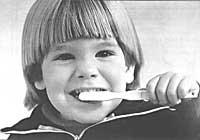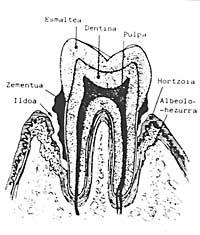Dental hygiene Dental hygiene
* Different dentures
* Types of teeth * CARIES
* ADEQUATE EDIBLE MEASURE
* DENTAL CLEANING
* FLUORO * FLUORO
Oral pathology is rare in the public. And oral diseases have so far been considered painful and not harmful to health.
Today, however, there is growing importance to oral pathology. Because:
- High oral resistance.
- Cavities and some bodily diseases (e.g. nephritis, endocarditis, acute polyarticular rheumatisms, etc.) maintain a close relationship.
- Oral pathology treatments are expensive. Prevention is also not too cheap, but a peseta that is spent on prevention saves between 25 and 50 pesetas in treatment.
- They are often the cause of school absenteism.
Dentures of teeth

When chewing food, the appliance used to cut and cut these foods is made up of teeth and teeth.
In the human being and in almost all mammals are distinguished two types of dentition:
- MILK DENTURES, TEETH AND FALLEN TEETH They begin to leave in the sixty-seventh month after birth. All appear for two and a half years. They are 20 pieces smaller and white than permanent.
- SECONDARY, PERMANENT or FINAL DENTURE Slowly replace the previous denture
- At six years the first rear tile is formed.
- Teeth at 8 years (incisive, central after lateral)
- At ten years, the anterior teeth appear.
- Fangs at the age of eleven
- At twelve years the second yew appears.
- At eighteen years the penultimate or the prudent
In total there are 32 pieces.
- CUTS. Its edges are pointed to cut food.
- FANGS. These also serve to cut food.
- PREMOLARS
Crushing and pressing of food
- REAR TACKS (MOLARES)
- Dairy dentures: 2 incisors, 1 fangs, 2 teeth (half jaw)
- Definitive dentition: 2 incisors, 1 fangs, 2 front teeth and 3 rear teeth each half jaw 2-1-2 (5 x 4 = 20 pieces) 2-1-2-3 (8 x 4 = 32 pieces)
In Bizkaia, in a study conducted by a Health Planning group, the following data were obtained in the population of Berriz from 1977-78:

What is caries? An alteration or mixture of dentures, a disease that, once produced, goes from the outside to the inside of the tooth. Without treatment this disease has no solution and the tooth is broken and broken.
In evolution there are several phases:
- INITIAL. Enamel caries: dark spot, no pain.
- SITUATION. Cold, heat, acid and sugar hurt. The dentin is also touched. It does not hurt when touching the tooth, but when touching the hole.
- CHRONICLE. The disease becomes chronic until it touches the pulp. Inflammation may also appear.
How does caries arise? We will cite 4 factors: BACTERIA, an adequate ROOT (sugar), ENAMEL and TIME.
Bacteria (mainly streptococci) break down sugar by forming acid. The acid “eats” the enamel and this enamel can also be melted if it was long time.
Root + Bacteria + Contact + Sugars = =CARIES
About 10% of children 2 years old have cavities. Children 3 years old, 40% have cavities. In children aged 4, 55% have cavities. In children 5 years old, 75% have cavities.
The same thing after: Between 6-8-10-12 years 20%, 60%, 85%, 90%.
Geographical regions also have great differences.
In 1971, the provinces with the highest number of jokes were, logically, proportionally: Logronio, Álava, Soria, Asturias, Navarra, Palencia, Santander, Zaragoza, Guipúzcoa, Málaga, Huelva, Granada, Ávila, Cáceres and Salamanca.
Prevention of prevention and prevention
All the prevention or treatment measures we currently have in our hands focus on the above mentioned factors.
- Against the BACTERIA. Vaccines, antiseptics.
- Against SUSTRAIA. Good measure of feeding (reducing sugars) and oral cleaning (eliminating dental plaque).
- ENAMEL. Fluoro, hardening the enamel and eliminating the starry enamel (or filling).
Below are some of these pathways.
No one denies the current influence of sugars on the formation of caries. When a backward or underdeveloped people enter into development, their food also changes radically: customs, propaganda, ... sugar consumption grows much and with it the number of bromers increases considerably.
Therefore, cavities can be considered an evil of civilization. In some non-industrialized villages, a few years ago this disease was hardly known.
Another factor to take into account is the influence of propaganda, etc. Especially in children: sweets, sugary drinks, chicles,...
On the other hand, it is very important to know the number of times that sugary foods are used or consumed every day. It is better to ingest the same amount of sugar once you distribute two or three times throughout the day.
Adherence of the different types of sugar. Solid sugar is less sticky than liquid sugar. For example, fruits such as apple have a lower adherence than sweet candies. Therefore, its elimination is much more complicated.
Another point to consider is the concentration of sucrose in foods. Preferably, foods with low concentrations of sucrose should be taken
Or replace sucrose with other sweets (xylitol, sorbitol, etc. ). ). In Switzerland, for example, they are used.
As for propaganda, a certain legal limitation may be required.
Food, pipes, popcorn, licorice, roasted corn, etc., recommended for children instead of sugars. best presentation.
This measure is not excessively effective against cavities. Cleaning the teeth can start from 3 to 4 years: at first with the help of parents, while learning the technique well. Then, they can do it alone.
After eating, we should clean our teeth every time. But especially at night, after dinner, since sugar and other foods will take longer to form the dental plaque.
There are many techniques suitable for brushing the teeth. Here we will give a possibility, just like the rest:
- First VERTICAL brushing
- Then clean the OCLUSAL SURFACE
- INTERDENTAL LINES
- Finally, use SILK THREAD.
For many reasons, the teeth can appear pigmented. Let's see the main reasons:
- For taking medications with iron or tetracyclines
- Epithelial remains. They leave when the tooth is removed.
- Foods, dyes, etc. By use.
In the first 12-14 years the fluoron binds to the enamel, which makes the enamel more resistant.
During the formation and formation of the tooth, the fluoride can be applied through the mouth, by ingestion. There are pills with fluoride and vitamins: VITAGAMA FLUOR (sale in pharmacies). There are also single-fluorine pills (not on sale between us): For example, ZIMAFLUOR.
Soon after, when the tooth is formed, fluoro is no longer attached to the enamel, so topical applications can be made with the so-called fluorine gel. These apps, for the moment, are manufactured by the dentist, in 4 sessions (weekly or monthly) and one more session per year.
- Abrasion so that the fluoro is put in contact with the enamel.
- Dry the teeth well.
- That room looked like a sponge and we will keep it in touch with the tooth for 5-10 minutes.
The fluoro can reach the enamel by different ways.
a) By water
- This is the best and cheapest way.
- The existence of complications has not been demonstrated.
- Thus we would reach everyone. It seems that the Basque Government, taking ORTUELLA as a pilot town, intends to flow the water. When not possible, it can be done in SCHOOLS.
- On this road you access the enamel throughout the day (by cleaning the mouth and teeth, with food, etc. ). ).
- The concentration of fluoros should be kept within a few measures depending on the temperature. The normally accepted concentration is one part per million (1 ppm). This requires special plants and facilities. Therefore, flowing water is not something that a particular person can do for himself.
b) WITH FLUORIDATED SALT
This path has been used in several Swiss cantons.
c) FLOUR-PILULEZ
When the above general pathways are not possible or are not legally given as in our case, fluoro is applied directly to dental enamel. How?
- MOUTHWASH BUCALES with fluoride solution.
- Using TOOTHPASTE with fluoros: 9 of every 10 in the market are of this type.
- Performing topical applications (seen above)
The following is the text of the recommendations submitted by the Basque Government to parents after the start of the School Dental Hygiene campaign as an example of a Health Education action:
- Your child has been taught how to care for the teeth and teeth, which should last a lifetime.
- Help him, then, reminding him that he has to wash himself after eating at home, especially at night.
- Do not forget that these tips or advice that you may not have before can also be beneficial to you. Take care of your oral hygiene.
- At 6 years old your child has a skewer that will be forever. You have to try to keep it for a lifetime.
- Remind your child that on Wednesdays you have to wash your mouth with a fluore-compound that will give strength to the tooth in school.
As a detail it can be said that the Eskimo did not know what was the Txantí art of the Second World War. When they had the first contacts with so-called civilization, all the harmful products that this entails forced them to invent the word “VAGINAL PAIN”.
Buletina
Bidali zure helbide elektronikoa eta jaso asteroko buletina zure sarrera-ontzian














